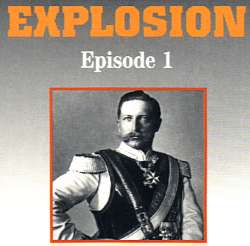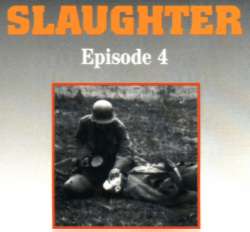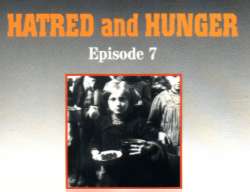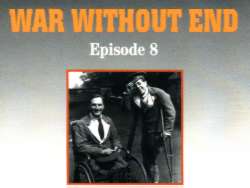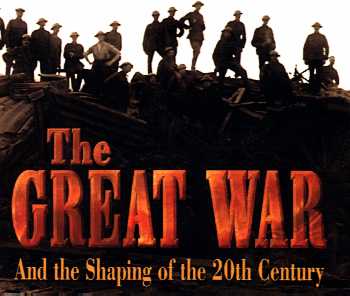 |
| The information below was made available by PBS VIDEO. Please direct any questions you may have regarding this information and/or materials to them. You may contact them by e-mail at: video@pbs.org or ø click here to proceed directly to the PBS Great War web site. |
|
THE GREAT WAR War in Bosnia...the struggle for peace in the Middle East...the Cold War and the Atomic Age...the spread of world democracy-much of today's world can't be fully understood until students learn about World War I and the unsettling peace that emerged afterwards. Now you can take high school and college students back to explore the events that set the course of the 20th century. THE GREAT WAR and the Shaping of the 20th Century portrays the historical events that occurred between 1890 and 1939 through the words and experiences of people who lived through them. Extensive primary resource material involves students in the sights and sounds of these turbulent times. Autobiographical accounts convey the thoughts and emotions of soldiers and civilians whose lives were forever changed by war. And interviews with leading scholars explain important historical concepts every student should know, including:
What Students Learn From THE GREAT WAR and the Shaping of the 20th Century:
Please note that the dates listed above are for the national feed of PBS. Local stations may vary, so be sure and check your local listings prior to the viewing date.
Introduce students to European life at the turn of the century, when new technologies were also creating an arms race among European super powers. Through portraits of Kaiser Wilhelm, II of Germany and Tsar Nicholas, II of Russia, students learn about the instability of the European monarchies and the diplomatic agreements that made war all but inevitable. Autobiographical accounts from ordinary citizens paint a vivid backdrop of the times including the labor movement and the fight in Britain over women's rights to vote. Students explore the conflicts between change and tradition that characterized life at this time and well into the 20th century.
Focusing on the period from August 4 to December 31, 1914, this episode relates the emotions and conditions that fueled the war efforts on all sides. Students learn how nationalism and propaganda demonized enemies and prolonged conflict, and how new technologies that were supposed to shorten war instead created weapons that were immune to human suffering. Autobiographical accounts reveal how civilians responded to the call for more volunteers and how the reality of war clashed with human expectations about victory and heroism. Archival photos show what life in the trenches was like and how men tried to adjust and cope. And a fascinating account of the unofficial "Christmas truce" of 1914 helps students understand how 19th century values and etiquette ended on the battlefields of Europe.
Explain to students why World War I was the first "total war" which involved civilians in the war effort as much as soldiers. Students learn how the war changed women's lives, how it changed government and law, and why factories and civilians become targets of military campaigns. Firsthand accounts from soldiers and civilians recount how new technologies, such as lethal gas and submarines, brought unrestricted warfare to everyone's lives and, with the sinking of the Lusitania, brought the U.S. and its citizens near to entering into the conflict. Plus, students learn how the mass killings of Armenians in Turkey, the first genocide of the 20th century, sets a precedent that Adolph Hitler chose to follow years later.
In paintings of Otto Dix and the words of Wilfred Owen and Siegfried Sassoon, students explore the horror of war and the battle of attrition that left many soldiers in the trenches wondering why they were fighting. Autobiographical accounts from soldiers at Verdun, the Somme, and Passchendaele, plus letters and diary entries from civilians, relive the suffering and conflicting emotions of wartime. Students examine the reasons why soldiers and generals and the governments they serve would continue to fight in the face of staggering losses-as many as 20,000 lives in one day. Plus, clips from the first war documentary, "The Battle of the Somme," reveal how mass media began to bring the horror of war home to the general public in a dramatic new way.
This episode explores the may ways that people in different roles tried to adjust to war or challenge authority. Examples from war literature capture the conditions and feelings of men at the front. The writings of soldiers and ordinary civilians dramatize the psychological effects of the war and offer powerful examples of what mechanized warfare can do to human beings. Students learn how shell-shocked men returning from the front lines are treated with a new technique, psychotherapy, and how grieving wives and parents turned to supernatural "visits" from their dead husbands and sons. Firsthand accounts of mutinous soldiers on the Western front and striking workers in the munitions factories help students better understand the events leading up to the Bolshevik revolution in Russia in 1917.
Use this episode to set the stage for student understandings of the long-term effects of World War I on world and U.S. history. Through autobiographical accounts and footage from Germany, students learn about mass mutinies, strikes and other events that caused the collapse of the war effort, which enabled German leaders after the war to claim that its army had not been defeated on the battlefield. Explain how German actions provoked the U.S. into the war, delivering a psychological boost to the Allied cause. And show students how the end of the war opened an opportunity for President Woodrow Wilson to propose a new world order based on the principles of democracy.
Focusing on the months preceding and just after the cease fire, this episode explains how the brutality of trench warfare was brought home to city streets in the forms of political assassinations, revenge, starvation and anarchy. Students learn how the war changed the world and why positive change was so difficult to attain. Firsthand accounts express the painful bitterness of German reparation and explain how the death of the Tsar affected the Russian people. Students explore many events and conditions that foreshadowed the post-war world, including the emergence of the Dada Movement, the efforts of Herbert Hoover to bring relief to millions, the confrontations between Bolsheviks and Allied forces in Russia and the prolonged blockade of Germany. Archival footage and first-person accounts describe how world leaders in Paris partitioned nations and unknowingly set the stage for conflicts to come.
This final episode explores the aftermath of war and the failed peace, including the painful efforts to deal with the losses suffered during the war and the climate in Germany that launched the political career of Adolph Hitler. Students explore writings and artwork from the "Lost Generation" and learn about cultural movements that focused on grieving, loss and spiritualism.
Video Series with Teaching Materials Scheduled Availability: November 1, 1996 Included when you buy the Deluxe Teaching Edition of THE GREAT WAR:
You may contact PBS VIDEO by e-mail at: video@pbs.org. | |||||||||||||||||||||||||||||||

